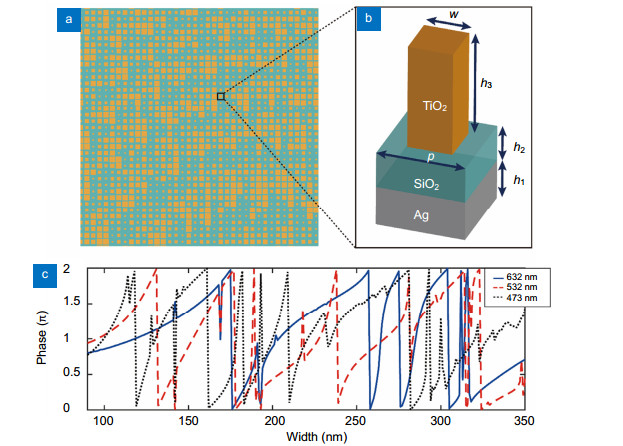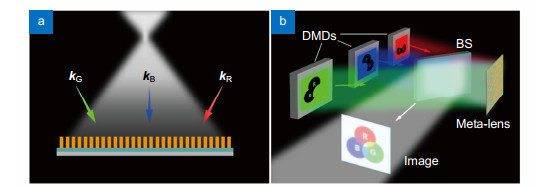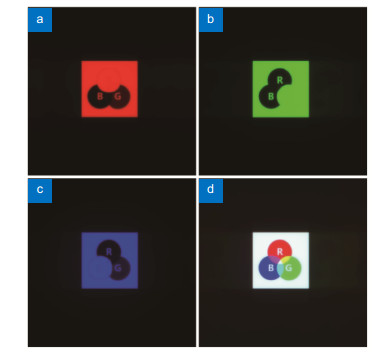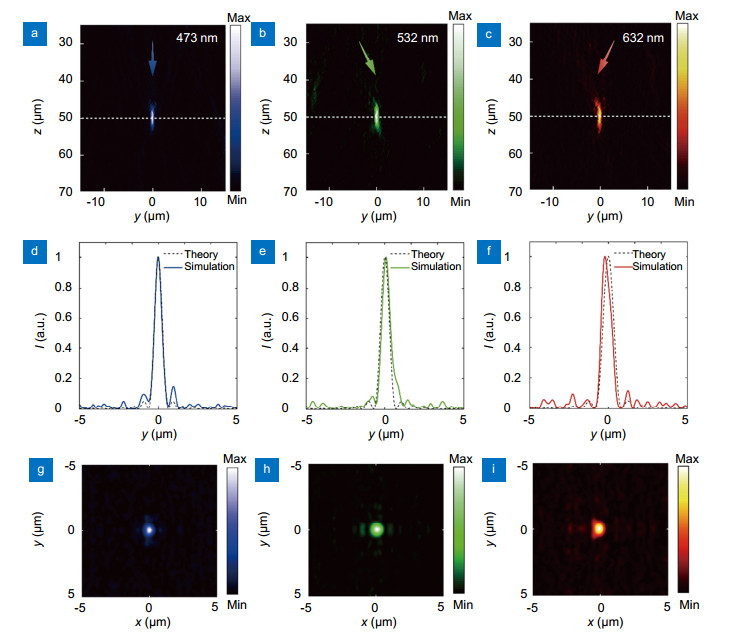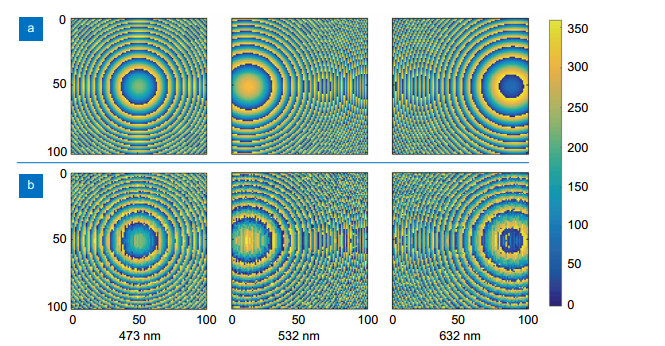-
Abstract
Dispersion control is crucial in optical systems, and chromatic aberration is an important factor affecting imaging quality in imaging systems. Due to the inherent property of materials, dispersion engineering is complex and needs to trade off other aberration in traditional ways. Although metasurface offers an effective method to overcome these limits and results in well-engineered dispersion, off-axis dispersion control is still a challenging topic. In this paper, we design a single-layer metalens which is capable of focusing at three wavelengths (473 nm, 532 nm, and 632 nm) with different incident angles (0°, -17° and 17°) into the same point. We also demonstrate that this metalens can provide an alternative for the bulky color synthetic prism in a 3-chips digital micromirror device (DMD) laser projection system. Through this approach, various off-axis dispersion controlling optical devices could be realized.
Keywords
-
Introduction
In recent years, as compact, lightweight devices which can break through the limitation of traditional optics, metasurfaces have attracted great attention of researchers4-6. As a subwavelength artificial electromagnetic material, the optical properties of metasurfaces depend on their materials and structural parameters. By optimizing the geometry size, arrangement and material properties of the sub-wavelength structure, one can flexibly control the amplitude, phase, and polarization of electromagnetic wave7, 8. Such abilities show their functionalities in various applications, such as nonlinear frequency conversion9, vortex beam generation10-12, holograms13-15, polarization manipulation16, flat lenses17-19, and virtual shaping20-23, etc. Typically, metasurfaces can reduce the system redundancy, but the chromatic aberration still exists24. Therefore, dispersion control has always been a key research topic in the design of metasurface devices. Previously reported works have studied a lot of the dispersion characteristics of metasurfaces. One method to control multi-wavelength dispersion is using the spatial multiplexing method18, 25-27. In these designs, each phase shifter is optimized for one individual wavelength, and multi-wavelength modulation is realized by interleaving multiple phase shifters in a single pixel. Nevertheless, the interleaving and cross-talk between different structures for different wavelengths will degrade the imaging quality, and the energy utilization of the incident light cannot exceed 1/n, where n is the number of modulation wavelengths. Recently, some dispersion-engineered approaches based on a single phase profile with wavelength dependence have been proposed to break the efficiency limitation17, 28, 29. Particularly, high refractive index and lossless titanium dioxide (TiO2) is usually selected to design high-efficiency metasurface devices in visible regime30, 31. These metasurfaces are mainly applied for normal incidence. However, in practical applications, such as laser beams combination and laser projection display systems, dispersion control under oblique incidence is unavoidable. It should be noted that, although some pioneering works on off-axis dispersion control through metallic nano-groove gratings have been reported32, they still face the significant limitation of efficiency. Multi-wavelength and multi-incident angle operations can also be achieved by vertical stacking of metasurfaces33, 34, while the volume and fabrication difficulty are inevitably increased.
Dispersion is an inherent property of a material. In general, dispersion would cause distortion of the signal and limit the operating bandwidth of devices. Dispersion control is an effective way to eliminate these effects. In general, dispersion control is mainly divided into two categories: amplification and elimination of dispersion. In spectroscopy and communication technology, strong dispersion is utilized to distinguish signals, such as spectrometer1 and dense wavelength-division multiplexing (DWDM)2. But in imaging systems, uncontrollable dispersion is a serious problem, which will greatly affect the imaging quality. In order to solve this problem, refraction and diffraction hybrid systems are generally used to eliminate the dispersion3. However, conventional refractive lenses are generally bulky and limited by the modulation mechanism, which will significantly constrain the performance of systems. With the development of processing technology and the increasingly high precision requirements, there is a potential to realize more compact, lightweight and integrated optical systems.
In this work, we present a single-layer metalens to focus three lights with different wavelengths (473 nm, 532 nm, and 632 nm) into the same point at different incident angles (0°, -17° and 17°). We first design the unit cells consisting of TiO2 nanopillars tiled on a dielectric spacer layer above a metallic mirror, which can provide special reflected phase responses at multi-wavelength. Then, to achieve the desired focus function, particle swarm optimization (PSO) algorithm is used to search the optimal phase profile and structure arrangement. Finally, we demonstrate that this metalens could provide an alternative for the color synthetic prism in a 3-chips DMD laser projection system, and the multi-color imaging behavior has been simulated.
Principle and design
![Figure 2.]()
(a) Top-view of part of the designed metalens. (b) The element consists of a titanium dioxide (TiO2) nanopillar (h3=530 nm) on top of a silicon dioxide (SiO2) layer (h2=180 nm) above a silver substrate (h1=200 nm). The period p=400 nm, the nanopillar has a square cross-section with width w. By adjusting the width, the reflection phase can be controlled. (c) Numerically calculated reflection phase shift as a function of w at three wavelengths of 473 nm, 532 nm, and 632 nm. As the nanopillar width w changes from 90 nm to 350 nm, the corresponding phase undergoes multiple 0-2π phase cycles. The refractive indexes of TiO2 are 2.493, 2.43 and 2.373 for 473 nm, 532 nm, and 632 nm in the simulations, respectively.To suppress the energy loss caused by high-order diffraction, the period of unit cells is selected to satisfy the Nyquist sampling criterion and should be less than λ/2NA. As shown in Fig. 2(b), we design a unit cell with a period of 400 nm. A square TiO2 nanopillar with a height of 530 nm is placed on a 180 nm thick SiO2 layer and a 200 nm thick silver is used as a reflective layer at the bottom. This subwavelength structure functions as a waveguide and supports guided mode resonances36, 37. Abnormal phase response occurs to decouple the realized phases at different wavelengths29. Using the commercial software, Computer Simulation Technology (CST) Microwave Studio, we sweep the width of the nanopillar (ranging from 90 nm to 350 nm) to obtain reflected phase response. Then we use these geometry parameters and the corresponding phase responses to build the structure-phase library. The simulated phase response is folded into multiple 2π cycles, as shown in Fig. 2(c). For the short wavelength of 473 nm which is close to the period, stronger guided mode resonance would be excited, resulting in large phase coverage and more phase jumps in the same width range. While for the long wavelength of 632 nm, the resonance becomes quite weak. Taking advantage of this anomalous dispersion property, we can use the single phase shifter to modulate the local phase for three wavelengths.
To realize the focusing function, a phase retardation should be offered to change the incident plane wave to a converging wave. The phase retardation of the optical lens is required to compensate the phase difference of propagation in free space, the required phase φ for incident wavelength λ can be written as:
From equations (1) and (2), the phase function varies with the wavelength and incident angle, which is the inherent dispersion in the process of light propagation. General achromatic metalenses just need to compensate the regular phase retardation of propagation in free space. However, in our case, the off-axis incident lights need to be deflected, thus the phase profile of each wavelength is no longer central symmetry distribution. The phase concentric rings deviate along the incident direction. We denote φλ(x, y) as the desired phase of one pixel at coordinate (x, y) for the wavelength λ. Here, the required phases at a pixel for different wavelengths may have a great difference (i.e., φλ1(x1, y1) ≠ φλ2(x1, y1)). Besides, the phases at different pixels are equal for one wavelength, but different for another wavelength (i.e., φλ1(x1, y1) = φλ1(x2, y2), φλ2(x1, y1) ≠ φλ2(x2, y2)). We design a single phase profile with wavelength dependence to modulate the three reflected waves (Fig. 2(a)). To achieve the desired function, we first build a structure-phase library which contains large phase response range. Parametric sweep is performed with a uniform step to obtain the corresponding reflected phase. Then we select the suitable structure from the library using PSO algorithm to match the desired phase at each pixel.
where f is the designed focal length, r=√x2+y2 indicates the distance from each pixel to the lens center, and n is the number of operating wavelengths. In contrast to the previous achromatic metalenses which only consider the normal incidence conditions, here the additional phase φd(λi) is used to compensate the off-axis (assuming the incident waves are in the xz-plane) aberration, as given by:
\varphi \left( {r, {\lambda _i}} \right) = \frac{{2{\rm{ \mathsf{ π} }}(f - \sqrt {{r^2} + {f^2}} )}}{{{\lambda _i}}} + {\varphi _{\rm{d}}}\left( {{\lambda _i}} \right) + C\left( {{\lambda _i}} \right), \quad i = 1, 2 \ldots n, ![Figure 1.]()
(a) Schematic of the off-axis multi-wavelength dispersion controlling metalens. The metasurface is illuminated by three lights with different wavelengths and incident angles, and then focuses the reflected lights into the same point. (b) Schematic of a 3-chips DMD laser projection system with the dispersion-engineered metalens. The three monochromatic (R, G and B) images can be synthesized into a color image after reflected by the metasurface. BS: beam splitter.where θ represents the incident angle. The desired phase profile would focus the lights with different wavelengths and different incident angles to the same point, as depicted in Fig. 1(a). For practical application, the dispersion-engineered metalens could be used in multi-color laser projection systems. Specifically, as shown in Fig. 1(b), three monochromatic red (R), green (G), and blue (B) projections from DMDs are reflected by the metasurface and finally form the output colorful images in the focal plane. According to the working principle of DMD35, the specific incident angles for the metalens are set as 0°, -17° and 17° for three lights, respectively. The focusing function is determined by the first two parts in equation (1), C (λi) is a constant phase and acts as a tuning knob in the design. We find the optimal value of C(λi) using the PSO algorithm to match the desired phase profile. Hence, we design a metalens with the numerical aperture (NA) of 0.38 and a focal length of 50 μm (Fig. 2(a)). Three lights with wavelengths of 473 nm, 532 nm, 632 nm irradiate on the metasurface at incident angles of 0°, -17° and 17°, respectively, and finally focus into the same point.
{\varphi _{\rm{d}}}\left( {{\lambda _i}} \right) = \frac{{2{\rm{ \mathsf{ π} }}}}{{{\lambda _i}}}x\sin \left( {{\theta _i}} \right), i = 1, 2 \ldots n Results and discussion
To evaluate the performance of the optimized phase distribution, we first calculate the intensity profile in the focal plane by vector angular spectrum theory. Then we obtain the corresponding structure parameters according to optimized phase distribution. Subsequently, full-wave simulations are carried out using CST Microwave Studio. In order to obtain the far-field intensity distribution at the focal plane, we calculate Fraunhofer diffraction of the surface field obtained from CST. Owing to the geometrical symmetry of the square pillar, the metasurface is insensitive to the polarization states of the incoming lights when the incident angle is small. The calculated results under transverse electric (TE) polarized illumination are given in Figs. 4(a)-4(c), which show normalized intensity distributions in the yz-plane for three wavelengths of 473 nm, 532 nm, and 632 nm. The corresponding focal lengths are respectively 49.9 μm, 49.45 μm and 50.05 μm. Figs. 4(d)-4(f) illustrate the calculated normalized intensity profiles of the three lights along the y-axis across the focal plane, the full-widths at half maximums (FWHMs) are 592 nm, 669 nm, and 730 nm, respectively, agree well with the theoretical counterparts (622 nm, 700 nm, and 831 nm, respectively). The slight deviations may be the result of approximate local phase distribution and a limited number of pixels in the simulations. The normalized intensity distributions in the xy- plane at the focal plane for three wavelengths of 473 nm, 532 nm, and 632 nm are also provided as shown in Figs. 4(g)-4(i). To demonstrate the polarization-independent property, the results for transverse magnetic (TM) polarized incidence are presented in Fig. S3, which show good agreement with that of TE polarized one. In general, the metalens exhibits excellent performance in off-axis multi-wavelength dispersion control.
In the following, we demonstrate the multi-color imaging of our metalens. First, we decompose a target full-color image into its RGB components. Then three DMD chips are used to generate monochromatic images as the incident sources, three monochromatic (R-632 nm, G-532 nm, and B-473 nm) images would be focused onto the center in the focal plane after reflected by the metalens, as shown in Figs. 5(a)-5(c). Owing to the ununiformed efficiency of the metalens for the three wavelengths, the reflected R, G and B images have an intensity ratio of 1: 0.878: 0.667 for the incidences with the same power. In order to make the synthetic color match with the target, we adjust the intensities of incident R, G, and B lights in the ratio of 1: 1.138 (i.e. 1/0.878): 1.5 (i.e. 1/0.667). For the three monochromatic images illuminating on the metalens simultaneously, the output signal will be a synthetic color image, as shown in Fig. 5(d).
![Figure 4.]()
(a-c) Numerically calculated normalized intensity distributions in the yz-plane at the wavelengths of 473 nm, 532 nm, and 632 nm under TE polarized incidence. The corresponding incident angles are 0°, -17° and 17°, respectively. (d-f) Theoretical (dotted lines) and calculated (solid lines) normalized intensity curves of the three lights along the y-axis across the focal plane. (g-i) Normalized intensity distributions in the xy-plane at the focal plane for the wavelengths of 473 nm, 532 nm, and 632 nm.Rayleigh criterion holds that the wavefront can be regarded as perfect when the maximum wave aberration between the actual wavefront and the ideal wavefront does not exceed λ/4. Moreover, if the defect portion occupies a small proportion of the total wavefront product, these local defects can be ignored even if the wave phase difference is greater than λ/4. This means that we do not need to find a subwavelength structure fully meets the ideal phase requirements, just need to meet most of the phase response requirements. To verify the performance of the off-axis multi-wavelength dispersion controlling metalens, a full model with the diameter of 40.4 μm and a focal length of 50 μm was designed (Fig. 2(a)). We discretize the phase profile into a matrix containing 101×101 pixels, and the ideal phase can be obtained by equations (1). In order to search the structure which is most suitable for the ideal phase, we need to find the structure phase response φs closest to the desired phase φd. Here, we perform this process by searching the minimum value of \Delta \varphi = {\varphi _{\rm{d}}} - {\varphi _{\rm{s}}} utilizing the PSO method. The ideal phase and optimized phase distributions for different wavelengths can be seen in Fig. 3. We calculate the phase error at each pixel on the metalens, which is the difference between the target phase (Fig. 3(a)) and actual phase (Fig. 3(b)), as seen in Fig. S1(a). The mean absolute errors of phase profile are 17.1°, 23.5° and 22.9° for the three wavelengths, respectively, the error histogram for each wavelength is shown in Fig S2(a). The corresponding reflectivity of each pixel is also calculated as shown in Figs. S1(b) and S2(b). The simulated focusing efficiencies are 47.82%, 52.04% and 51.82% for 473 nm, 532 nm, and 632 nm, respectively.
Conclusion
In summary, we have demonstrated a single-layer metasurface that can realize off-axis (±17°) multi-wavelength (473 nm, 532 nm, and 632 nm) dispersion engineering in the visible spectrum. Multi-color laser lensing and imaging are well demonstrated. Along with the design of metasurface with free phase for each wavelength, this design can break the constraints of conventional optics and explore new components with desired dispersion. We believe that this work could offer a new access for the design of off-axis multi-wavelength dispersion-engineered metadevices, and may find promising applications in multi-color imaging optical systems.
Acknowledgements
We acknowledge the financial support by the National Natural Science Foundation of China under contact Nos. 61622508, 61622509, and 61575201.
Competing interests
The authors declare no competing financial interests.
-
References
Yang C A, Edwards P, Shi K B, Liu Z W. Proposal and demonstration of a spectrometer using a diffractive optical element with dual dispersion and focusing functionality. Opt Lett 36, 2023-2025 (2011).
DOI: 10.1364/OL.36.002023Gong Y D, Li T J, Jian S S. Multi-channel fiber grating for DWDM. Chin J Electron 9, 292-295 (2000).
Stone T, George N. Hybrid diffractive-refractive lenses and achromats. Appl Opt 27, 2960-2971 (1988).
DOI: 10.1364/AO.27.002960Luo X G, Tsai D, Gu M, Hong M H. Extraordinary optical fields in nanostructures: from sub-diffraction-limited optics to sensing and energy conversion. Chem Soc Rev 48, 2458-2494 (2019).
DOI: 10.1039/c8cs00864gLuo X G, Tsai D, Gu M, Hong M H. Subwavelength interference of light on structured surfaces. Adv Opt Photonics 10, 757-842 (2018).
DOI: 10.1364/AOP.10.000757Nemati A, Wang Q, Hong M H, Teng J H. Tunable and reconfigurable metasurfaces and metadevices. Opto-Electron Adv 1, 180009 (2018).
DOI: 10.29026/oea.2018.180009View full references list -
Cited by
Periodical cited type(105)
1. Wei, H., Hu, W., Hu, J. et al. 3D printed near-infrared high-numerical aperture achromatic metalens. Iscience, 2025, 28(6): 112628. DOI:10.1016/j.isci.2025.112628 2. Li, X., Yu, H., Chen, Y. An inverse design method of discrete wavelength achromatic graphene oxide planar lens based on improved genetic algorithm | [基于改进遗传算法的离散波长消色差氧化石墨烯平面透镜逆向设计方法]. Yi Qi Yi Biao Xue Bao Chinese Journal of Scientific Instrument, 2025, 46(4): 11-22. DOI:10.19650/j.cnki.cjsi.J2413296 3. Zhang, K., Lu, H., Li, M. et al. High-efficiency rectangular transverse air-gap metalens for visible light based on a dual-coupled PB phase. Optics Letters, 2025, 50(6): 2101-2104. DOI:10.1364/OL.549532 4. Gao, X., Liu, Y., Chen, H. et al. All-dielectric bifocal metalens with diffraction-limited focusing and polarization-dependent characteristics. International Journal of Mechanical Sciences, 2025. DOI:10.1016/j.ijmecsci.2025.109916 5. Zheng, C.-L., Ni, P.-N., Xie, Y.-Y. et al. On-chip light control of semiconductor optoelectronic devices using integrated metasurfaces. Opto Electronic Advances, 2025, 8(1): 240159. DOI:10.29026/oea.2025.240159 6. Zhu, L., Zhang, H., Dong, L. et al. Dynamic Attention Mixer-Based Residual Network Assisted Design of Holographic Metasurface. Photonics, 2024, 11(10): 963. DOI:10.3390/photonics11100963 7. Xu, X., Qiao, S., Guo, Y. et al. Optical Information Encryption Based on Secret Sharing Liquid Crystal Elements with Spatial Dislocation. Laser and Photonics Reviews, 2024, 18(10): 2400168. DOI:10.1002/lpor.202400168 8. Zhang, R., Guo, Y., Zhang, F. et al. Dual-Layer Metasurface Enhanced Capacity of Polarization Multiplexing. Laser and Photonics Reviews, 2024, 18(9): 2400126. DOI:10.1002/lpor.202400126 9. Li, M., Guo, Z., Zhang, C. et al. Multi-wavelength single-pixel non-line-of-sight imaging with a compressive sensing measurement matrix. Applied Physics B Lasers and Optics, 2024, 130(7): 127. DOI:10.1007/s00340-024-08265-2 10. Shi, J., Qiao, W., Zhou, F. et al. A see-through combiner based on pixelated intertwined flat lens for full-color glasses-free augmented reality. Optics and Lasers in Engineering, 2024. DOI:10.1016/j.optlaseng.2024.108147 11. Yang, Y., Xin, H., Liu, Y. et al. Intelligent metasurfaces: Integration of artificial intelligence technology and metasurfaces. Chinese Journal of Physics, 2024. DOI:10.1016/j.cjph.2024.03.043 12. Liu, L., Zhang, Y., Chen, J. et al. Energy-efficient dispersion compensation for digital micromirror device. Optics Express, 2024, 32(8): 13946-13954. DOI:10.1364/OE.521743 13. Chen, H., Feng, Q., Wu, J. et al. Polarization-insensitive dual-wavelength dispersion tunable metalens achieved by global modulation method. Optics Communications, 2024. DOI:10.1016/j.optcom.2023.130181 14. Chen, Y., Ding, Y., Yu, H. et al. Design of an Achromatic Graphene Oxide Metalens with Multi-Wavelength for Visible Light. Photonics, 2024, 11(3): 249. DOI:10.3390/photonics11030249 15. Bian, C., Zhou, D., Zhang, D. et al. Multifunctional Folded Transmitarray Antenna (MFTA) with Independent Control of Beam and Polarization Using Reconfigurable Metasurface. Advanced Materials Technologies, 2024, 9(3): 2301774. DOI:10.1002/admt.202301774 16. Li, Z., Lv, Y. Optimization for Si Nano-Pillar-Based Broadband Achromatic Metalens. IEEE Photonics Journal, 2024, 16(1): 1-7. DOI:10.1109/JPHOT.2024.3359324 17. Lei, Z.-D., Xu, Y.-D., Lei, C. et al. Dynamic multifunctional metasurfaces: an inverse design deep learning approach. Photonics Research, 2024, 12(1): 123-133. DOI:10.1364/PRJ.505991 18. Yuan, H., Zhang, B., Zhong, Z. Polarization-encoded optical secret sharing based on a dielectric metasurface incorporating near-field nanoprinting and far-field holography. Optics Express, 2023, 31(26): 43934-43949. DOI:10.1364/OE.505549 19. Gao, H., Fan, X., Wang, Y. et al. Metasurface-Based Orbital Angular Momentum Multi-Dimensional Demultiplexer and Decoder. Laser and Photonics Reviews, 2023, 17(12): 2300393. DOI:10.1002/lpor.202300393 20. Xu, J., Yue, Z., Lu, P. et al. Wavelength and polarization dual-multiplexed imaging based on holographic metasurfaces. Chinese Optics Letters, 2023, 21(10): 100501. DOI:10.3788/COL202321.100501 21. Liu, K., Gong, T., Luo, Y. et al. Ultrasensitive enhanced Raman spectroscopy by hybrid surface-enhanced and interference-enhanced Raman scattering with metal-insulator-metal structures. Optics Express, 2023, 31(10): 15848-15863. DOI:10.1364/OE.488410 22. Huang, J., Wang, Y., Yuan, L. et al. Large-Area and Flexible Plasmonic Metasurface for Laser–Infrared Compatible Camouflage. Laser and Photonics Reviews, 2023, 17(3): 2200616. DOI:10.1002/lpor.202200616 23. Yuan, Y., Gao, L., Luo, Y. et al. Ag@ZIF-67 nanocomposites for ultra-sensitive SERS detection to thiram molecules. Journal of Physics D Applied Physics, 2023, 56(5): 055302. DOI:10.1088/1361-6463/acadea 24. Faraz, F., Li, Z., Zhang, Z. et al. High-Efficiency Geometric Phase Metasurface with Multifold Rotationally Symmetric Resonators. ACS Applied Optical Materials, 2023, 1(1): 173-178. DOI:10.1021/acsaom.2c00027 25. Zhongyue, L., Wentao, Z., Libo, Y. et al. Fiber-integrated catenary wave-driven metasurfaces for beam focusing. Proceedings of SPIE the International Society for Optical Engineering, 2023. DOI:10.1117/12.3008053 26. Chen, K., Li, J., Zhu, G. et al. Phase-assisted angular-multiplexing nanoprinting based on the Jacobi-Anger expansion. Optics Express, 2022, 30(26): 46552-46559. DOI:10.1364/OE.479137 27. Chu, Z., Li, T., Wang, J. et al. Polarization-multiplexed full-space metasurface simultaneously merging with an ultrawide-angle antireflection and a large-angle retroreflection. Optics Express, 2022, 30(25): 45776-45791. DOI:10.1364/OE.474762 28. Hu, Y., Liu, Z., Sun, T. et al. Local Zoom Imaging System Using Liquid Crystal Lens | [利 用 液 晶 透 镜 实 现 的 局 部 变 倍 成 像 系 统]. Guangxue Xuebao Acta Optica Sinica, 2022, 42(23): 2311001. DOI:10.3788/AOS202242.2311001 29. Khaidarov, E., Eschimese, D., Lai, K.H. et al. Large-scale vivid metasurface color printing using advanced 12-in. immersion photolithography. Scientific Reports, 2022, 12(1): 14044. DOI:10.1038/s41598-022-18259-9 30. Zhang, X.G., Sun, Y.L., Zhu, B. et al. A metasurface-based light-to-microwave transmitter for hybrid wireless communications. Light Science and Applications, 2022, 11(1): 126. DOI:10.1038/s41377-022-00817-5 31. Xu, X., Luo, X.-Q., Liu, Q. et al. Plasmonic Sensing and Switches Enriched by Tailorable Multiple Fano Resonances in Rotational Misalignment Metasurfaces. Nanomaterials, 2022, 12(23): 4226. DOI:10.3390/nano12234226 32. Gou, Y., Ma, H.F., Wu, L.W. et al. Non-Interleaved Polarization-Frequency Multiplexing Metasurface for Multichannel Holography. Advanced Optical Materials, 2022, 10(22): 2201142. DOI:10.1002/adom.202201142 33. Liu, Y., Gao, H., Fan, X. et al. Polarization-independent 3D metasurface with complex amplitude modulation. Optics Express, 2022, 30(21): 37686-37696. DOI:10.1364/OE.470718 34. Jiang, H., Zhu, W., Huang, J. et al. Active metasurface in the near-infrared region by gating ultrathin TiN films. Optics Letters, 2022, 47(19): 5072-5075. DOI:10.1364/OL.472187 35. Shao, Z., Xie, X., Zhou, Y. et al. Planar liquid crystal optics for simultaneously surface displaying and diffraction-limited focusing. Nanophotonics, 2022, 11(19): 4455-4463. DOI:10.1515/nanoph-2022-0410 36. Yang, Y., Kim, H., Badloe, T. et al. Gap-plasmon-driven spin angular momentum selection of chiral metasurfaces for intensity-tunable metaholography working at visible frequencies. Nanophotonics, 2022, 11(17): 4123-4133. DOI:10.1515/nanoph-2022-0075 37. Dong, L., Kong, W., Wang, C. et al. Quasi-continuous metasurface for high-efficiency beam deflection based on multi-objective level-set optimization. Optical Materials Express, 2022, 12(9): 3667-3678. DOI:10.1364/OME.470765 38. Kanyang, R., Fang, C., Yang, Q. et al. Electro-Optical Modulation in High Q Metasurface Enhanced with Liquid Crystal Integration. Nanomaterials, 2022, 12(18): 3179. DOI:10.3390/nano12183179 39. Ma, Q., Liu, C., Xiao, Q. et al. Information metasurfaces and intelligent metasurfaces. Photonics Insights, 2022, 1(1): R01. DOI:10.3788/PI.2022.R01 40. Zhao, M., Yu, B., Du, J. et al. Focusing Characteristics and Widefield Imaging Performance of the Silicon Metalens in the Visible Range. Micromachines, 2022, 13(8): 1183. DOI:10.3390/mi13081183 41. Hasan, M.M., Islam, M.T., Moniruzzaman, M. et al. Symmetric Engineered High Polarization-Insensitive Double Negative Metamaterial Reflector for Gain and Directivity Enhancement of Sub-6 GHz 5G Antenna. Materials, 2022, 15(16): 5676. DOI:10.3390/ma15165676 42. He, C., Song, Z. Terahertz graphene metasurfaces for cross-polarized deflection, focusing, and orbital angular momentum. Optics Express, 2022, 30(14): 25498-25508. DOI:10.1364/OE.462330 43. Zheng, Y., Xu, M., Pu, M. et al. Designing high-efficiency extended depth-of-focus metalens via topology-shape optimization. Nanophotonics, 2022, 11(12): 2967-2975. DOI:10.1515/nanoph-2022-0183 44. Long, Y., Zhang, J., Liu, Z. et al. Metalens-based stereoscopic microscope. Photonics Research, 2022, 10(6): 1501-1508. DOI:10.1364/PRJ.456638 45. Zhang, H., Gao, P., Li, X. et al. Numerical and experimental analysis of patterning multi-period and multi-radius metasurfaces. Materials Today Advances, 2022. DOI:10.1016/j.mtadv.2022.100247 46. Gao, N., Zhang, Z., Deng, J. et al. Acoustic Metamaterials for Noise Reduction: A Review. Advanced Materials Technologies, 2022, 7(6): 2100698. DOI:10.1002/admt.202100698 47. Hao, J., Ma, T., Ye, Z. et al. Simulation for multiwavelength large-aperture all-silicon metalenses in long-wave infrared. Nanotechnology, 2022, 33(22): 225203. DOI:10.1088/1361-6528/ac547b 48. Luo, X., Pu, M., Zhang, F. et al. Vector optical field manipulation via structural functional materials: Tutorial. Journal of Applied Physics, 2022, 131(18): 181101. DOI:10.1063/5.0089859 49. Xie, Y., Zhang, J., Wang, S. et al. Broadband achromatic polarization-insensitive metalens in the mid-wave infrared range. Applied Optics, 2022, 61(14): 4106-4112. DOI:10.1364/AO.454303 50. Cai, J., Zhang, F., Pu, M. et al. Broadband and high-efficiency photonic spin-Hall effect with all-metallic metasurfaces. Optics Express, 2022, 30(9): 14938-14947. DOI:10.1364/OE.455381 51. Wang, J., Pu, M., Jin, J. et al. Generation of A Space-Variant Vector Beam with Catenary-Shaped Polarization States. Materials, 2022, 15(8): 2940. DOI:10.3390/ma15082940 52. Deng, L., Li, Z., Zhou, Z. et al. Bilayer-Metasurface Design, Fabrication, and Functionalization for Full-Space Light Manipulation. Advanced Optical Materials, 2022, 10(7): 2102179. DOI:10.1002/adom.202102179 53. Zhang, H., Zhang, Z., Ma, X. et al. Polarization multiplexing metasurface for dual-band achromatic focusing. Optics Express, 2022, 30(7): 12069-12079. DOI:10.1364/OE.454805 54. Chen, L., Shao, Z., Liu, J. et al. Multi-wavelength achromatic bifocal metalenses with controllable polarization-dependent functions for switchable focusing intensity. Journal of Physics D Applied Physics, 2022, 55(11): 115102. DOI:10.1088/1361-6463/ac3e2e 55. Wang, J., Zhang, Z., Huang, C. et al. Transmission–Reflection-Integrated Quadratic Phase Metasurface for Multifunctional Electromagnetic Manipulation in Full Space. Advanced Optical Materials, 2022, 10(6): 2102111. DOI:10.1002/adom.202102111 56. Wang, Z., Wu, Y., Qi, D. et al. Progress in the design, nanofabrication, and performance of metalenses. Journal of Optics United Kingdom, 2022, 24(3): 033001. DOI:10.1088/2040-8986/ac44d8 57. Deng, M.-J., Zhao, Y.-Y., Liang, Z.-X. et al. Maximizing energy utilization in DMD-based projection lithography. Optics Express, 2022, 30(4): 4692-4705. DOI:10.1364/OE.448231 58. Lei, Y., Guo, Y., Pu, M. et al. Multispectral Scattering Imaging Based on Metasurface Diffuser and Deep Learning. Physica Status Solidi Rapid Research Letters, 2022, 16(2): 2100469. DOI:10.1002/pssr.202100469 59. Zhao, J., Kong, W., Wang, C. et al. Planar Hyperspectral Imager with Small Smile and Keystone Based on Two Metasurfaces. IEEE Photonics Journal, 2022, 14(1) DOI:10.1109/JPHOT.2021.3132421 60. Zhang, S., Huo, P., Wang, Y. et al. Generation of achromatic auto-focusing Airy beam for visible light by an all-dielectric metasurface. Journal of Applied Physics, 2022, 131(4): 043104. DOI:10.1063/5.0077930 61. Yang, Y., Zhang, X., Liu, K. et al. Complex-Amplitude Metasurface Design Assisted by Deep Learning. Annalen Der Physik, 2022. DOI:10.1002/andp.202200188 62. Zhou, Y., Yan, C., Tian, P. et al. A super-oscillatory step-zoom metalens for visible light. Beilstein Journal of Nanotechnology, 2022. DOI:10.3762/bjnano.13.101 63. Han, Y., Chen, P., Wang, M. et al. SPPs directional excitation of linearly polarized light based on catenary nanoparticle metasurface | [基于悬链线纳米粒子超构表面的线偏振光 SPPs 定向激发]. Guangdian Gongcheng Opto Electronic Engineering, 2022, 49(10): 220105. DOI:10.12086/oee.2022.220105 64. Gang, Y., Yinghui, G., Mingbo, P. et al. Miniature computational spectral detection technology based on correlation value selection | [基于相关性选择的微型计算光谱探测技术]. Guangdian Gongcheng Opto Electronic Engineering, 2022, 49(10): 220130. DOI:10.12086/oee.2022.220130 65. Zhang, Y.X., Pu, M.B., Jin, J.J. et al. Crosstalk-free achromatic full Stokes imaging polarimetry metasurface enabled by polarization-dependent phase optimization. Opto Electronic Advances, 2022, 5(11): 220058. DOI:10.29026/oea.2022.220058 66. Luo, X., Zhang, F., Pu, M. et al. Recent advances of wide-angle metalenses: Principle, design, and applications. Nanophotonics, 2022, 11(1): 1-20. DOI:10.1515/nanoph-2021-0583 67. Zeng, C., Lu, H., Mao, D. et al. Graphene-empowered dynamic metasurfaces and metadevices. Opto Electronic Advances, 2022, 5(4): 200098. DOI:10.29026/oea.2022.200098 68. Ma, X., Song, R., Fan, Z. et al. Phase-change metasurface by u-shaped atoms for photonic switch with high contrast ratio. Coatings, 2021, 11(12): 1499. DOI:10.3390/coatings11121499 69. Plidschun, M., Ren, H., Kim, J. et al. Ultrahigh numerical aperture meta-fibre for flexible optical trapping. Light Science and Applications, 2021, 10(1): 57. DOI:10.1038/s41377-021-00491-z 70. Chen, Q., Nan, X., Chen, M. et al. Nanophotonic Color Routing. Advanced Materials, 2021, 33(49): 2103815. DOI:10.1002/adma.202103815 71. Lee, D., Kim, M., Rho, J. Next-generation imaging techniques: Functional and miniaturized optical lenses based on metamaterials and metasurfaces. Micromachines, 2021, 12(10): 1142. DOI:10.3390/mi12101142 72. Tian, X., Xu, J., Xu, K. et al. Ge2Sb2Te5-based reconfigurable metasurface for polarization-insensitive, full-azimuth, and switchable cloaking. Applied Optics, 2021, 60(26): 8088-8096. DOI:10.1364/AO.434912 73. Ren, R., Li, Z., Deng, L. et al. Non-orthogonal polarization multiplexed metasurfaces for tri-channel polychromatic image displays and information encryption. Nanophotonics, 2021, 10(11): 2903-2914. DOI:10.1515/nanoph-2021-0259 74. Luo, X., Li, X., Pu, M. et al. Symmetric and asymmetric photonic spin-orbit interaction in metasurfaces. Progress in Quantum Electronics, 2021. DOI:10.1016/j.pquantelec.2021.100344 75. Li, Z., Tang, F., Shang, S. et al. Compact metalens-based integrated imaging devices for near-infrared microscopy. Optics Express, 2021, 29(17): 27041-27047. DOI:10.1364/OE.431901 76. Chen, M., Wen, L., Pan, D. et al. Full-color nanorouter for high-resolution imaging. Nanoscale, 2021, 13(30): 13024-13029. DOI:10.1039/d1nr02166d 77. Liu, Y.-J., Zhang, F., Xie, T. et al. Polarization-multiplexed metalens enabled by adjoint optimization | [基于伴随仿真的偏振复用超构透镜]. Chinese Optics, 2021, 14(4): 754-763. DOI:10.37188/CO.2021-0035 78. Yue, Z., Zheng, C., Li, J. et al. A dual band spin-selective transmission metasurface and its wavefront manipulation. Nanoscale, 2021, 13(24): 10898-10905. DOI:10.1039/d1nr02624k 79. He, Q., Zhang, F., Pu, M. et al. Monolithic metasurface spatial differentiator enabled by asymmetric photonic spin-orbit interactions. Frontiers in Optics and Photonics, 2021. DOI:10.1515/9783110710687-062 80. Duan, Y., Zhang, F., Pu, M. et al. Polarization-dependent spatial channel multiplexing dynamic hologram in the visible band. Optics Express, 2021, 29(12): 18351-18361. DOI:10.1364/OE.425000 81. Li, Z., Wang, C., Kong, W. et al. Broadband achromatic metasurface filter for apodization imaging in the visible | [用于可见光波段切趾成像的宽带消色差超表面滤波器]. Guangdian Gongcheng Opto Electronic Engineering, 2021, 48(5): 200466. DOI:10.12086/oee.2021.200466 82. Xie, X., Pu, M., Jin, J. et al. Generalized Pancharatnam-Berry Phase in Rotationally Symmetric Meta-Atoms. Physical Review Letters, 2021, 126(18): 183902. DOI:10.1103/PhysRevLett.126.183902 83. Yang, G., Zhang, F., Pu, M. et al. Dual-wavelength multilevel diffractive lenses for near-infrared imaging. Journal of Physics D Applied Physics, 2021, 54(17): 175109. DOI:10.1088/1361-6463/abe07d 84. Li, J., Wang, G., Zheng, C. et al. All-silicon metasurfaces for polarization multiplexed generation of terahertz photonic orbital angular momentum superposition states. Journal of Materials Chemistry C, 2021, 9(16): 5478-5485. DOI:10.1039/d1tc00594d 85. Zhang, Z., Wang, J., Pu, M. et al. Broadband Achromatic Transmission–Reflection-Integrated Metasurface Based on Frequency Multiplexing and Dispersion Engineering. Advanced Optical Materials, 2021, 9(7): 2001736. DOI:10.1002/adom.202001736 86. Li, Z., Wang, C., Wang, Y. et al. Super-oscillatory metasurface doublet for sub-diffraction focusing with a large incident angle. Optics Express, 2021, 29(7): 9991-9999. DOI:10.1364/OE.417884 87. Xu, M., Pu, M., Sang, D. et al. Topology-optimized catenary-like metasurface for wide-angle and high-efficiency deflection: From a discrete to continuous geometric phase. Optics Express, 2021, 29(7): 10181-10191. DOI:10.1364/OE.422112 88. Ha, Y., Guo, Y., Pu, M. et al. Monolithic-Integrated Multiplexed Devices Based on Metasurface-Driven Guided Waves. Advanced Theory and Simulations, 2021, 4(2): 2000239. DOI:10.1002/adts.202000239 89. Zheng, G., Zhou, N., Deng, L. et al. Full-space metasurface holograms in the visible range. Optics Express, 2021, 29(2): 2920-2930. DOI:10.1364/OE.417202 90. Zhang, Y., Pu, M., Guo, Y. et al. High-efficiency mid-infrared catenary metasurface for chiral spectrometer. Proceedings of SPIE the International Society for Optical Engineering, 2021. DOI:10.1117/12.2604314 91. Xie, T., Zhang, F., Bao, H. et al. Infrared multispectral imaging system based on metasurfaces for two infrared atmospheric windows. Proceedings of SPIE the International Society for Optical Engineering, 2021. DOI:10.1117/12.2604345 92. Cai, J., Yu, H. Monolithic all-dielectric metasurface for simultaneous linear dichroism and wavefront manipulation. Proceedings of SPIE the International Society for Optical Engineering, 2021. DOI:10.1117/12.2604170 93. Yang, G., Zhang, F., Liu, Y. et al. Broadband achromatic multilevel diffractive lens at visible frequency. Proceedings of SPIE the International Society for Optical Engineering, 2021. DOI:10.1117/12.2604484 94. Feng, X., Zhang, F., Pu, M. et al. Simultaneous thermal infrared camouflage and laser scattering with thermal management based on an ultra-thin metasurface. Proceedings of SPIE the International Society for Optical Engineering, 2021. DOI:10.1117/12.2604483 95. Wang, Y., Fan, Q., Xu, T. Design of high efficiency achromatic metalens with large operation bandwidth using bilayer architecture. Opto Electronic Advances, 2021, 4(1): 1-7. DOI:10.29026/oea.2021.200008 96. Nemati, A., Wang, Q., Ang, N.S.S. et al. Ultra-high extinction-ratio light modulation by electrically tunable metasurface using dual epsilon-near-zero resonances. Opto Electronic Advances, 2021, 4(7): 200088. DOI:10.29026/oea.2021.200088 97. Fang, C., Yang, Q., Yuan, Q. et al. High-q resonances governed by the quasi-bound states in the continuum in all-dielectric metasurfaces. Opto Electronic Advances, 2021, 4(6): 200030. DOI:10.29026/oea.2021.200030 98. Gao, H., Fan, X., Xiong, W. et al. Recent advances in optical dynamic meta-holography. Opto Electronic Advances, 2021, 4(11): 210030. DOI:10.29026/oea.2021.210030 99. Chen, P., Chen, C., Qin, S. et al. Efficient planar plasmonic directional launching of linearly polarized light in a catenary metasurface. Physical Chemistry Chemical Physics, 2020, 22(47): 27554-27559. DOI:10.1039/d0cp05095d 100. Lu, X., Guo, Y., Pu, M. et al. Switchable polarization-multiplexed super-oscillatory metasurfaces for achromatic sub-diffraction focusing. Optics Express, 2020, 28(26): 39024-39037. DOI:10.1364/OE.413078 101. Moon, S.-W., Kim, Y., Yoon, G. et al. Recent Progress on Ultrathin Metalenses for Flat Optics. Iscience, 2020, 23(12): 101877. DOI:10.1016/j.isci.2020.101877 102. Luo, X., Pu, M., Guo, Y. et al. Catenary Functions Meet Electromagnetic Waves: Opportunities and Promises. Advanced Optical Materials, 2020, 8(23): 2001194. DOI:10.1002/adom.202001194 103. Xie, T., Zhang, F., Pu, M. et al. Integrated multispectral real-time imaging system based on metasurfaces. Optics Express, 2020, 28(24): 36445-36454. DOI:10.1364/OE.411353 104. Shen, Y., Xie, X., Pu, M. et al. Achromatic metalens based on coordinative modulation of propagation phase and geometric phase | [基于传输相位和几何相位协同调控的消色差超透镜]. Guangdian Gongcheng Opto Electronic Engineering, 2020, 47(10): 200237. DOI:10.12086/oee.2020.200237 105. He, Q., Zhang, F., Pu, M. et al. Monolithic metasurface spatial differentiator enabled by asymmetric photonic spin-orbit interactions. Nanophotonics, 2020, 10(1): 741-748. DOI:10.1515/nanoph-2020-0366 Other cited types(0)
-
Author Information
-
Supplementary Information
TitleActions -
Copyright
Open Access. © The Author(s). This article is licensed under a Creative Commons Attribution 4.0 International License. To view a copy of this license, visit http://creativecommons.org/licenses/by/4.0/. -
About this Article
Cite this Article
Kaihua Dou, Xin Xie, Mingbo Pu, et al. Off-axis multi-wavelength dispersion controlling metalens for multi-color imaging. Opto-Electronic Advances 3, 190005 (2020). DOI: 10.29026/oea.2020.190005Download CitationArticle History
- Received Date March 04, 2019
- Accepted Date April 06, 2019
- Available Online April 19, 2020
- Published Date April 20, 2020
Article Metrics
Article Views(13945) PDF Downloads(4266)
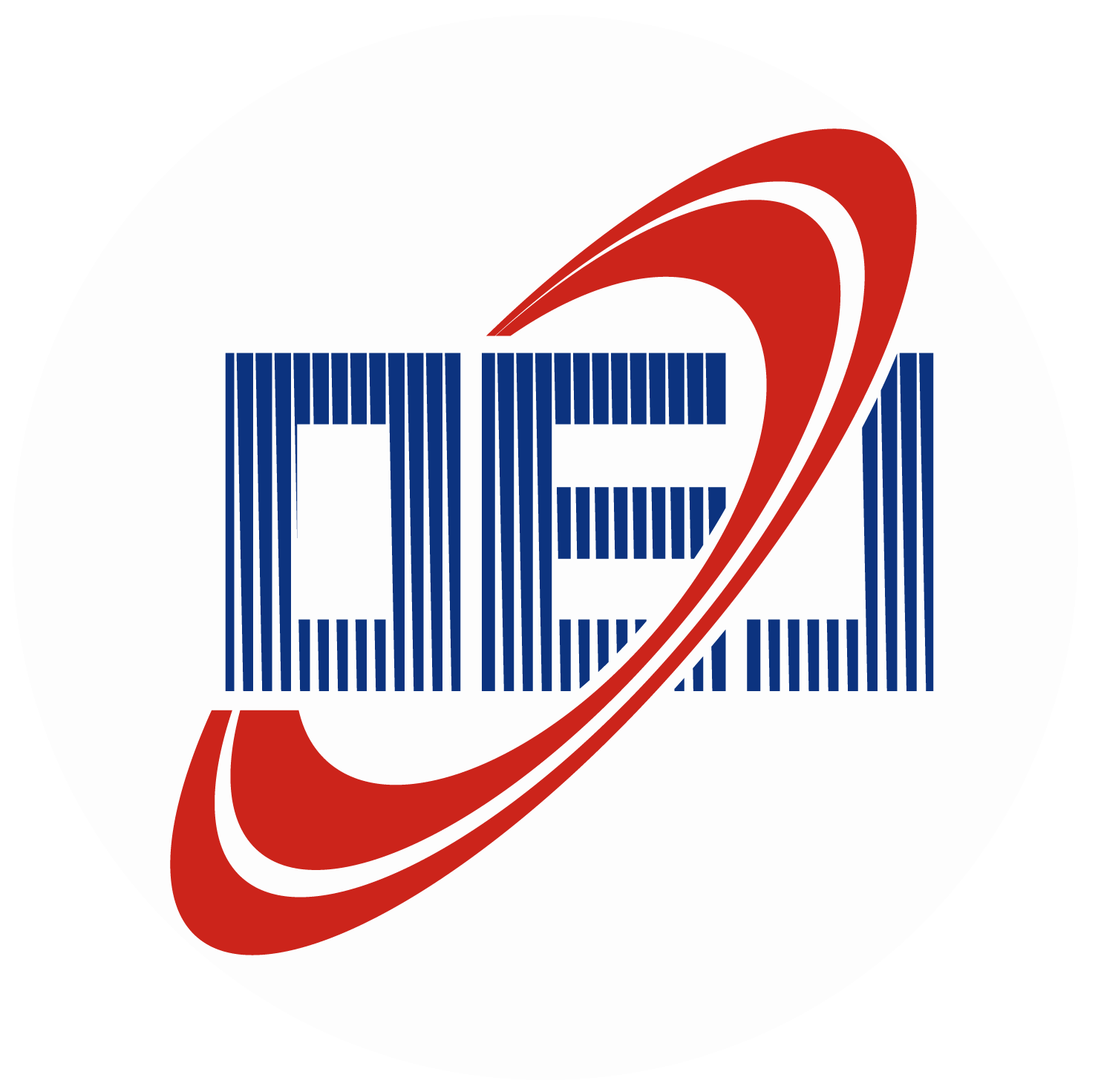

 E-mail Alert
E-mail Alert RSS
RSS
